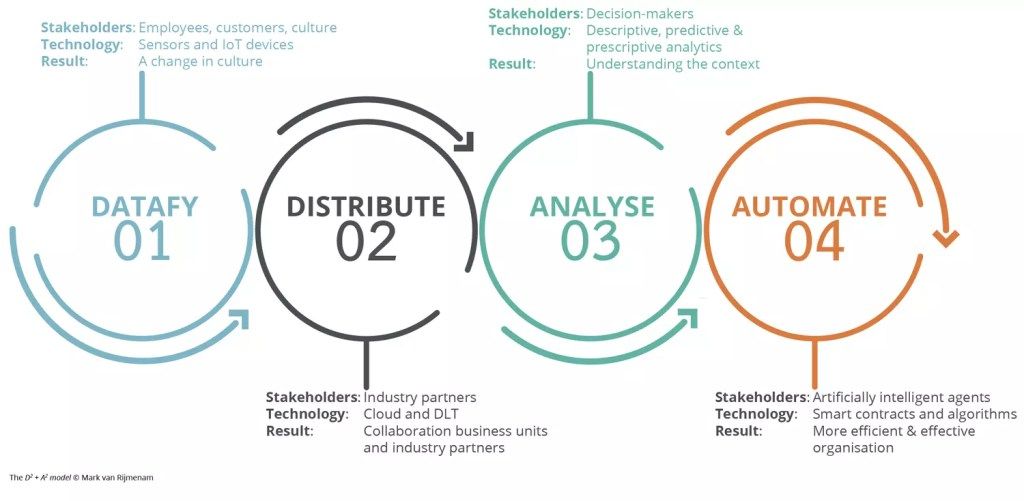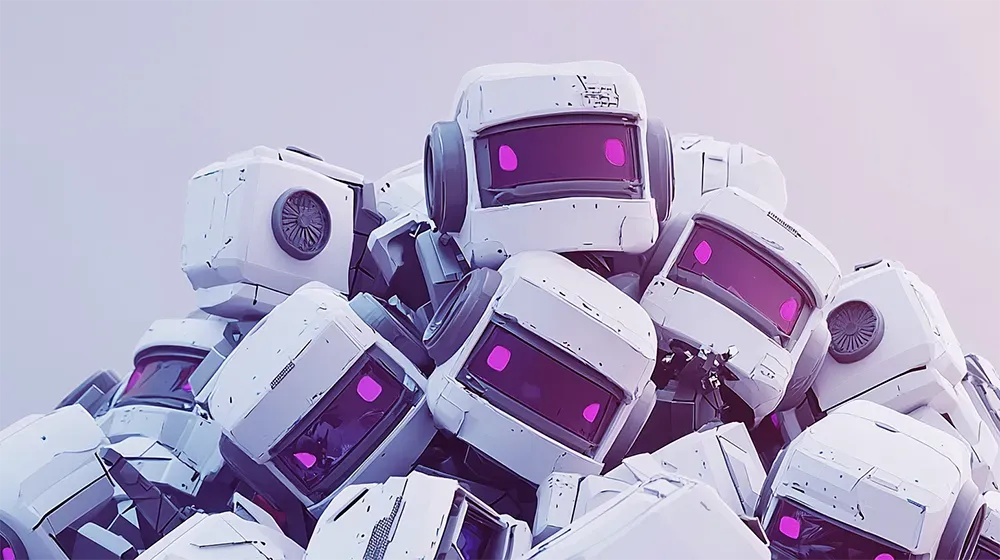How to Build the Organisation of Tomorrow?

A question that I get asked a lot is how should organisations navigate today’s digital transformation? An interesting question that encompasses different layers. It depends on who asks the question, the company involved, the industry the company is in, the size of the company, etc. Since the arrival of information technologies, digital transformation has been on the agenda for many organisations. Most of these organisations seem to be struggling with it.
With the appearance of the first wave of ‘advanced’ IT in the 1990s, the nature of organisations changed. IT changes organisation design, intelligence, management and decision-making. With that, digitalisation often shifts the power balance within an organisation, altering existing relationships among stakeholders. As a result, information technologies tend to create flatter organisations. Bottom line, IT drastically affects organisations. So, what to do when organisations have to deal with advanced IT such as analytics or artificial intelligence?
A Model for Digital Transformation
During my PhD at the University of Technology Sydney, I have tried to answer that question. How will emerging information technologies, such as big data analytics, blockchain and AI, affect organisations? What should organisations do to remain competitive in the increasingly digital world we live in? My PhD is nearly finished as I submitted my dissertation a few weeks ago. Currently, I am working on transforming my dissertation into an easy to read and digest management book. It will be available in Q1 2019. In the book, I set out to develop a model for digital transformation, which I would like to share with you here.
The D2 + A2 Model
The organisation of tomorrow will be built around data. Therefore, the first step is to datafy your organisation and collect data at every process and customer touch point. The second step in the organisation of tomorrow is to distribute that data. Either using centralised databases in the cloud or decentralised databases using distributed ledger technology. The third step is to analyse the data. This will enable you to find patterns and make sense of it. The final step in building the organisation of tomorrow is to automate it using AI. This will enable you to leverage the data and embed smartness in every process and customer touchpoint. This leads us to the secret sauce to building the organisation of tomorrow:

The D2+A2 model
Datafy
Transforming your organisation into a data organisation requires above all data. To achieve that, the first step is to datafy your organisation. Datafication is the process of making a business data-driven. It involves transforming social action into quantified data. This means, collecting (new) data from various sources and processes using IoT devices or creating detailed 360-degrees customer profiles.
Datafying your organisation starts by making your office, your workplace, your processes and your products or services smart. This will make previously ‘invisible’ processes traceable, allowing you to monitor, analyse and optimise them. Thanks to the lowering costs of sensors, increasing low-cost bandwidth, cheap availability of cloud-computing and processing capacity, it has become easier and cheaper to make these processes smart. It will help you capture data consistently and universally across different processes, products and workplaces.
Of course, data quality is of utmost importance when datafying your organisation. Low-quality and biased data is useless and can even cause damage to your organisation and customers. Therefore, within tomorrow’s organisation, data governance will become very important.
Distribute
Once you collect data within every process and customer touch point, it is, of course, important to store that data in order to use it. There are two ways of doing so. Ideally, the organisation of tomorrow will make use of a combination of two technologies. First of all, you can distribute the data using distributed ledger technologies such as blockchain.
Although the decentralised ecosystem is still under development, it can be beneficial to all industries. However, no matter how promising blockchain is, it does not mean that every problem requires a decentralised solution. A decentralised solution is only required when there is a trust issue (which happens when individuals, organisations and things want to collaborate across organisational borders or between individuals and things) and when a transaction is taking place.
In other occasions, distributed ledger technology is not the required technology. You are better of using cloud computing technology. The cloud can be especially useful to store, analyse, visualise and share data within an organisation. Especially, when it does not matter that there is a centralised database. Naturally, this would be the case for transactions being done within one organisation and without external stakeholders being involved.
Analyse
After collecting data in every company process and customer touchpoint and storing the data in a distributed way, it is time to analyse that data using analytics. For many businesses, the path to creating competitive advantage is by using ‘big data’ and subjecting it to (advanced) analytics. There are several levels of practices of big data analytics, each increasing in complexity and the value they create: descriptive analytics, diagnostic analytics, predictive analytics and prescriptive analytics.
When facing big data, analytics come with multiple benefits. Such as improved utilisation of resources and increased insight into patterns and habits of consumers. In addition, it offers organisations better insights on the impact of new technologies or techniques and the changing environment.
Therefore, analytics have become a pre-requisite for a company facing uncertainty. To understand the environment and better grasp the context, an organisation cannot survive without analytics. It is required to understand what is going on and to know how to respond to changes in the context of the organisation.
Automate
The final step in transforming your organisation into a data organisation is to automate your business processes and augment your customer touchpoints with AI. Artificial intelligence will become especially valuable if you have completed the first three steps. After all, AI requires large amounts of high-quality and unbiased data. Exactly what the organisation of tomorrow will have after datafying different business processes and distributing the data using DLT or the cloud.
In addition, thanks to data provenance, it becomes possible to understand better why an algorithm came to a certain decision. Data provenance offers a traceable overview of the collected and used data. The end goal of the organisation of tomorrow is to develop artificial intelligence that becomes increasingly advanced, resulting in increased productivity and efficiency.
To start automating your organisation, the right process would be to do so in small steps. It is impossible to build a fully automated business from scratch due to the complexity involved with AI. As I wrote earlier, AI is like Lego. It requires small steps to build something beautiful. Especially, when you also consider smart contracts to automate the organisation. While AI can be used to automate internal business processes, smart contracts can be used to automate external business processes where other stakeholders are involved.
Preparing for the future
Together, the above four steps make up the D2 + A2 model. Summarising, to develop the organisation of tomorrow, an organisation should datafy their processes and customer touch points, ensuring high-quality data and the right data governance practices are in place.
Once collected, the data can then be distributed either using distributed ledger technologies to enable trustless transactions. This will allow for collaboration with industry stakeholders. Or you can store data in the cloud to offer employees access to one single version of data across the organisation.
The third step is to analyse that data. Various data mining techniques can reveal patterns across data sources. This will result in a better understanding of the changing context of the organisation.
Finally, the organisation of tomorrow uses artificially intelligent agents such as immutable smart contracts and algorithms to automate business processes and augment your customer touchpoints, resulting in a more efficient and effective organisation.
These four steps will offer a competitive advantage. It will turn your organisation into a data organisation that is ready for the data-driven future ahead of us.
New Book: The Organisation of Tomorrow
The D2 + A2 model described here, is part of my new book called The Organisation of Tomorrow. I am very much curious to learn your feedback on this model and if and how it could be improved. Obviously, in the book it will be discussed in a lot more detail. The book discusses how emerging information technologies are changing the organisation and how organisations can transform their organisation into a data organisation. If you wish to be notified when the book is available, you can subscribe to my newsletter here.
Image: Gorodenkoff/Shutterstock





